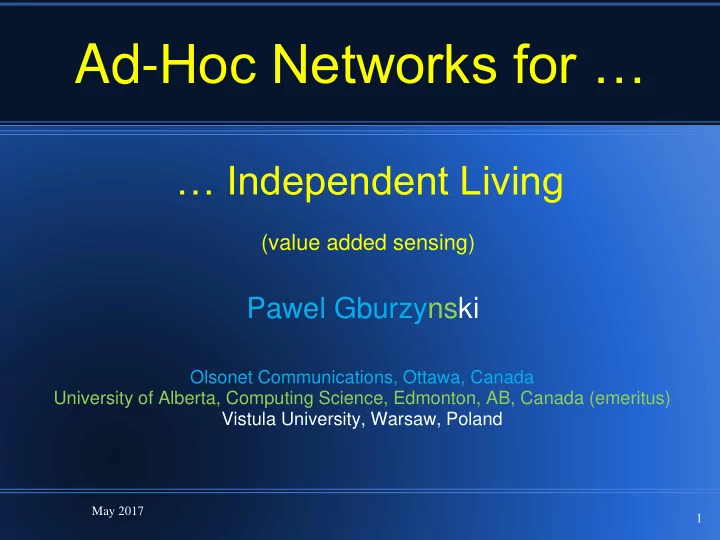

Ad- Hoc Networks for … … Independent Living (value added sensing) Pawel Gburzynski Olsonet Communications, Ottawa, Canada University of Alberta, Computing Science, Edmonton, AB, Canada (emeritus) Vistula University, Warsaw, Poland May 2017 1
Militza (Brugges) collaboration with Alphatronics, Belgium May 2017 2
Annonciaden (Antwerp) collaboration with Alphatronics, Belgium May 2017 3
What to sense? acceleration position the abominable panic button movement LF-loops local remote … control RSS location independence monitoring tracking simplicity May 2017 4
Alphanet highlights true Ad-Hoc (as opposed to sensor-to-access-point) mobility, e.g., trips, field events (system on the road) flexible, proprietary semi-infrastructure ISM band, ≠ BT, ≠ ZigBee, ≠ WiFi integrated, virtual development platform complete, authoritative, virtual development and testing May 2017 5
Alphanet highlights May 2017 6
TARP the ubiquitous, network-wide communication scheme: selective, cache-driven flooding (re-casting) A B slack = 1 May 2017 7
The forwarder’s dilemma ? P-P TARP ❖ where should I forward the ❖ should I transmit (broadcast) packet? the packet? ❖ how can I learn the identity of ❖ will I help when I do that? the next node on the path? ❖ won’t my assistance be ❖ how do I make sure to know redundant? that identity at all times? May 2017 8
Tags and Pegs Pegs the same low end hardware base for all device types, e.g., CC430 by TI: 4K RAM simple ISM RF module Tags typical rate: 38.4 kbps low energy May 2017 9
The praxis: Tags & Pegs Tags implement some end functionality, e.g., sensing; a Tag can be mobile Pegs act as semi-infrastructure (e.g., static, devoid of sensors/actuators, used solely for communication) Pegs can be used as reference, e.g., for location tracking (those that do not move) Pegs can be powered from external sources, while Tags are battery powered everybody can forward, if needed (flexible roles) May 2017 10
Praxis development: PicOS May 2017 11
Praxis development: VUE 2 Virtual Underlay Execution Engine (an authoritative emulator for complete praxes) May 2017 12
Praxis development: VUE 2 the praxis Virtual Underlay Execution Engine (an authoritative emulator for complete praxes) May 2017 13
Indoor location tracking based solely on crude RSS, yet surprisingly accurate (for the task at hand) May 2017 14
Pegs as anchors direct transformation of RSS into distance doesn’t work (subtler correlation is needed) we can afford many Pegs (redundant coverage doesn’t pollute the RF channel) profiling: manual, automated, hinted (by other location indicators, e.g., LF loop sensors, chargers) May 2017 15
Location bursts series of 32 short packets transmitted at increasing power levels (in groups of 4): . . . PL 0 PL 1 PL 7 Pegs receive what they can and forward the corresponding RSS vectors to the OSS May 2017 16
A sample Peg # loc 1'0'2, att 5 "23-Apr-2017 19:59:03 ” power level 3 0 0 0 61 68 77 90 95 4 0 57 66 76 85 94 105 112 5 0 60 70 79 88 96 108 115 6 74 83 92 102 111 119 131 138 7 82 89 99 109 118 125 137 145 8 75 84 93 102 111 119 132 138 9 82 91 100 109 119 126 139 145 11 0 0 0 69 77 85 97 104 12 0 0 0 0 0 60 73 80 … P0 P1 P7 May 2017 17
Like RFID/ranging combo low power levels have priority; this way closeness to a Peg tends to result in a good estimate allows for sparse coverage in areas where tolerance can be afforded: no need to be close to a Peg for a “reasonably good” estimate history option, i.e., tracking versus (infrequent, on- demand locating) May 2017 18
A few numbers for what they are worth RF range: 100 m ballpark in open air (minimal antennas), 10-50 m in a building, depending on wall type … practical accuracy (on-demand [alarm] mode): 90%+ recommended coverage: 1.5 Pegs per “location” energy budget (Tag): ca. 4 mAs per burst: 1 b/h 1.2 uA extra current drain, idle current: ca. 3 uA, 1 event/h 20 years on a 1 Ah (3 V) battery May 2017 19
That’s it May 2017 20
Recommend
More recommend